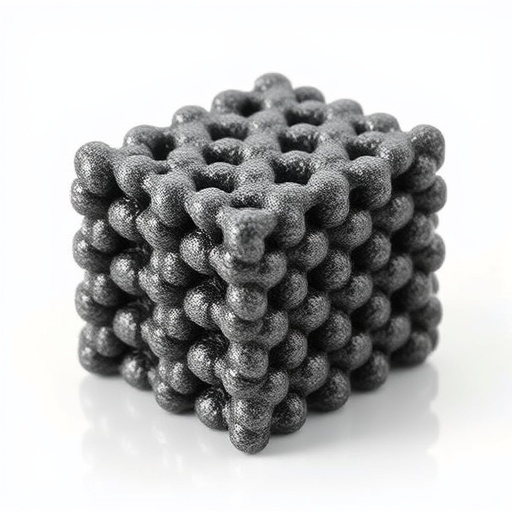Recent advancements in the field of energy storage technology have emphasized the need for materials that can provide enhanced performance, particularly in supercapacitor applications. Among these materials, metal oxides have garnered significant attention for their high capacitance, stability, and conductivity. A groundbreaking study has recently been published, detailing the enhanced electrochemical performance of an innovative composite material created from amorphous iron oxide and boron, derived specifically from α-Fe₂O₃. This particular research, led by notable scientists including Sudarshana, Rajiv, and Balan, offers critical insights into how composite materials can revolutionize the efficiency of supercapacitors.
Supercapacitors are increasingly regarded as a viable alternative to traditional batteries due to their rapid charge and discharge capabilities along with their lifespan longevity. However, for supercapacitor technologies to reach their full potential, the materials employed must exhibit excellent electrochemical performance under operational conditions. The study unveiled that the amorphous iron oxide/boron composite showcases significant improvements in capacitance, energy density, and cycling stability—all crucial factors for commercial viability.
The primary focus of this research was on how the structural characteristics and composition of the amorphous iron oxide, combined with boron, affect the material’s electrochemical properties. The study utilized advanced synthesis techniques to ensure that the final composite would benefit from both the conductive properties of boron and the electrochemical versatility of iron oxide. It’s essential to highlight that transforming iron oxide from a crystalline to an amorphous state significantly alters its electrochemical characteristics, resulting in enhanced performance metrics.
The researchers undertook meticulous experiments to assess the charge-discharge cycles associated with the amorphous iron oxide/boron composite. Their findings revealed that the composite maintained a remarkably high capacitance even after numerous cycles, indicating excellent stability. This finding is particularly noteworthy, as one of the significant drawbacks of existing supercapacitor materials is their tendency to degrade over time. The impressive cycling stability of the composite opens the doors for its applicability in various energy storage systems, especially in renewable energy environments.
Moreover, the study conducted electrochemical impedance spectroscopy, which further supported the claim of the material’s exceptional performance. The low internal resistance observed in the composite material suggests it can efficiently transport charge, a crucial requirement for high-power applications. This characteristic positions the amorphous iron oxide/boron composite as a strong contender in the landscape of energy storage solutions, especially where quick energy retrieval is necessary, such as in electric vehicles and grid storage systems.
In addition to the conductive properties, the researchers have pointed out the composite’s increased surface area thanks to its amorphous structure. A larger surface area facilitates a higher availability of active sites for electrolytic reactions, thus improving the overall performance of the supercapacitor. This finding aligns well with previous studies that suggest that surface characteristics of materials play a pivotal role in determining their electrochemical behavior.
Another fascinating aspect of this research is the environmental implications of using an amorphous iron oxide/boron composite. Given the increasing demand for sustainable and eco-friendly materials, the use of abundant and non-toxic elements like iron and boron makes this composite attractive for commercial production. This eco-conscious approach not only addresses the performance of energy storage systems but also aligns with global efforts to reduce reliance on rare and hazardous materials commonly found in conventional batteries.
As the researchers delve deeper into understanding the mechanism behind the enhanced performance of the amorphous iron oxide/boron composite, they also highlight the need for future investigations. Future studies would aim to optimize the synthesis process further and incorporate other materials that could complement the existing composite, potentially leading to even better electrochemical properties.
The innovative findings from this research add a new dimension to the understanding of supercapacitor technology. With the calculated design of materials at the nanoscale, coupled with the application of amorphous structures, the future of energy storage appears promising. The merging of iron oxide with boron not only exhibits practicality but also serves as a template for future research on composite materials in energy applications.
In conclusion, the work presented in this pioneering study sets a solid foundation for future investigations into high-performance energy storage systems. By leveraging the properties of amorphous iron oxide and boron, the researchers have opened avenues for new designs of supercapacitor materials that are not only efficient but also sustainable. The implications of this research extend beyond just performance metrics, potentially reshaping the landscape of energy storage technologies.
Potential applications based on this composite could redefine how energy is stored and utilized globally. With the world moving toward more sustainable energy solutions, the findings of this research could significantly influence the next generation of supercapacitor technologies. The results reinforce the idea that innovative material science can lead to tangible changes in how we approach energy storage and usage in our everyday lives.
As we await further developments from this research group, it is clear that the future of energy storage lies in the clever design of materials and their composite forms. The study not only highlights the importance of iron oxide and boron in creating superior materials but also serves as inspiration for future efforts in material innovation for various applications in energy technology.
Ultimately, this research exemplifies how interdisciplinary approaches in material science can lead to remarkable advancements in critical areas such as energy storage, paving the way for a more sustainable and electrified future.
Subject of Research: Enhanced electrochemical performance of amorphous iron oxide/boron composite
Article Title: Enhanced electrochemical performance of amorphous iron oxide/boron composite derived from α-Fe2O3 for supercapacitor applications.
Article References:
Sudarshana, R., Rajiv, A., Balan, R. et al. Enhanced electrochemical performance of amorphous iron oxide/boron composite derived from α-Fe2O3 for supercapacitor applications.
Ionics (2025). https://doi.org/10.1007/s11581-025-06705-3
Image Credits: AI Generated
DOI: https://doi.org/10.1007/s11581-025-06705-3
Keywords: supercapacitors, amorphous iron oxide, boron composite, energy storage, electrochemical performance, cycling stability, sustainability.
Tags: advancements in battery alternativesamorphous iron oxide supercapacitor performanceboron composite materials for energy storagecomposite materials in energy applicationscycling stability in energy storageenergy density improvements in supercapacitorsenhanced electrochemical propertieshigh capacitance materials in supercapacitorsinnovations in supercapacitor technologyrapid charge discharge supercapacitor capabilitiesstability and conductivity in metal oxidesα-Fe₂O₃ derived materials






